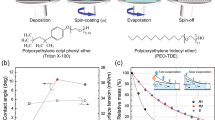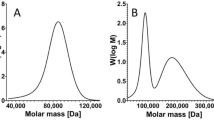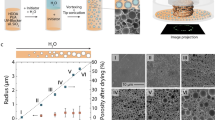Abstract
AN important challenge in the preparation of porous polymer membranes for technological applications is to control both the size distribution and the relative positions of the pores. We have found a way to generate polymer films with an essentially monodisperse pore size, in which the pores are organized spontaneously into periodic hexagonal arrays. The films, which are 10–30 um thick, are produced by evaporating solutions of star-shaped polystyrene or polystyrene-polyparaphenylene block copolymers in carbon di-sulphide under a flow of moist gas. Empty spherical cells, about 0.2–10 µm in diameter, appear spontaneously in a hexagonal array, and the cells are open at the film surface. The use of star polymers, or of polymeric micelles, seems to be essential for obtaining this morphology. These membranes might find application in controlled release of drugs or other bioactive species, or as materials with useful optical properties, moulds or scaffolding for forming ordered microstructures, and model substrates for surface science.
This is a preview of subscription content, access via your institution
Access options
Subscribe to this journal
Receive 51 print issues and online access
$199.00 per year
only $3.90 per issue
Buy this article
- Purchase on Springer Link
- Instant access to full article PDF
Prices may be subject to local taxes which are calculated during checkout
Similar content being viewed by others
References
Zhong, X. F. & François, B. Synth. Metals 29, 35–40 (1989).
Zhong, X. F. & François, B. Makromolek. Chem. 192, 2277–2291 (1991).
François, B. & Zhong, X. F. Synth. Metals 41–43, 955–958 (1991).
Widawski, G., Rawiso, M. & François, B. J. Chim. Phys. 89, 1331–1336 (1992).
Widawski, G. thesis, Univ. Strasbourg (1993).
Worsfold, D. J., Zilliox, J. G. & Rempp, P. Can. J. Chem. 47, 3379–3385 (1969).
Kesting, R. E. in Synthetic Polymer Membranes Ch. 7 (Wiley, New York, 1985).
Gan, Y. S., Sarazin, D., Guenet, J. M. & François, J. Polymer 29, 898–903 (1988).
Leshaini, N., Boudenne, N., Zilliox, J. G. & Sarazin, D. Macromolecules (in the press).
Author information
Authors and Affiliations
Rights and permissions
About this article
Cite this article
Widawski, G., Rawiso, M. & François, B. Self-organized honeycomb morphology of star-polymer polystyrene films. Nature 369, 387–389 (1994). https://doi.org/10.1038/369387a0
Received:
Accepted:
Issue Date:
DOI: https://doi.org/10.1038/369387a0
This article is cited by
-
Formation of polymeric filtration membranes by the combination of emulsion and breath figures approach
Journal of Porous Materials (2023)
-
Production technology and applications of honeycomb films
Polymer Journal (2022)
-
Self-assembling nanofibrous bacteriophage microgels as sprayable antimicrobials targeting multidrug-resistant bacteria
Nature Communications (2022)
-
Ordered porous films of biomass-based polymers by breath figure: a review
Cellulose (2022)
-
Drying paths of phase-separating solution coatings exposed to humidity
Journal of Coatings Technology and Research (2022)
Comments
By submitting a comment you agree to abide by our Terms and Community Guidelines. If you find something abusive or that does not comply with our terms or guidelines please flag it as inappropriate.



